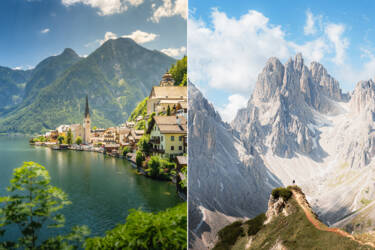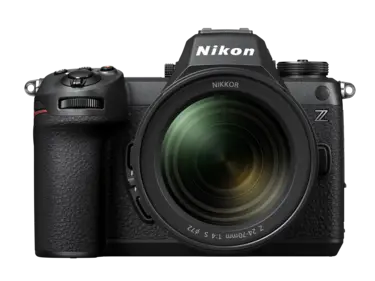Elevating your travel stills and video

Master your camera settings, craft cinematic videos and improve your composition
If, like our Nikon photographers, you are using these longer days and warmer months as an excuse to upgrade your travel stills and video, then these tips will do just the trick.
Play with layering and leading lines
Says who? Travel, astro and landscape photographer and videographer Sergio Diaz
“I like to include foreground elements like rocks, plants or structures to frame the scene and add depth, dimension and context. I also prefer wide compositions, playing with perspective and contrasting light so the image feels alive and doesn’t fall into that flat, over-edited Instagram look.”
Use PhotoPills to watch the sunlight
Says who? Food and travel photographer and videographer Solli Kanani
“Summer sun often means harsh summer light, so planning is important. I use the PhotoPills app to see where the sun will rise and set in the area I am travelling to. I try to avoid photographing at midday, wherever possible. I prefer working with soft, natural light, either early in the morning or around sunset, when the light is warmer and more flattering.”
Nikon Team
What’s in our kitbag?

D750 + NIKKOR AF-S 50mm f/1.4G, 1/200, f/3.2, ISO 100, ©Solli Kanini
Enhance contrast with a polarising filter
Says who? Food and travel photographer and videographer Solli Kanani
“When photographing in harsh summer light, I always make sure to bring a polarising filter, as it’s fantastic for reducing reflections and enhancing contrast, especially when photographing lakes and skies. For video, I rely on ND filters, ideally a 1-5 stop variable ND, which gives me flexibility to maintain a cinematic shutter speed even in bright conditions.”
Read more: The essential guide to filters: what to use for snow, water and effects
Pack light
Says who? Food and travel photographer and videographer Solli Kanani
“Know exactly what you’re going to bring with you. I love using my NIKKOR Z 105mm f/2.8 VR S with my Z7II to capture fine details and the hidden life of nature. For broader scenes, my NIKKOR AF-S 16-35mm f/4G ED VR (with a Mount Adapter FTZ II) is perfect for landscapes. When I want to travel light, especially for short city breaks, I bring the Nikon Zfc, which is a fantastic all-rounder and great for street photography.”
Different lenses in action. Left to right: NIKKOR AF-S 16-35mm f/4G ED VR at 35mm (Venice), NIKKOR AF-S 50mm f/1.4G (Paris), NIKKOR AF-S 70-200mm f/2.8E FL ED VR at 122mm (Lavender) and NIKKOR Z 105mm f/2.8 VR S (Bee).
Reflect the mood and soul of the location
Says who? National Geographic Traveller Photography Award 2025 winner Scott Antcliffe
“Focus on what makes the destination feel alive – the small, authentic moments that go beyond the surface, whether it’s an interaction between locals, the texture of a weathered wall or a fleeting dash of light that reveals something unique about the place. It’s about being present, observant and patient. I watch how people move, how light falls at different times of day and how the environment interacts with daily life. It’s often a gut feeling. When a scene captures a sense of rhythm, emotion or contrast, I know it speaks to the heart of that place. I love using shadows, colour and light not just for aesthetics, but as storytelling tools. Harsh midday light might reveal texture and grit; soft golden light can bring warmth and intimacy. Shadows add mystery and depth, while bold colours can express the vibrancy of a culture. It’s about using these elements to reflect the mood and soul of a location, not just its look.”

Z9 + NIKKOR Z 24-70mm f/2.8 S, 29mm, 1/125 secs, f/4, ISO 1000, ©Scott Antcliffe
Don’t forget insurance
Says who? Wildlife photographer Roie Galitz
“Whether you’re a professional or a hobbyist, capturing at home or travelling abroad – get insurance. Pros should make sure their policy covers professional use, new gear value and international travel. From my experience, insurance companies don’t like paying out. Make sure you get a proper policy, not a cheap one.”
Read more: What to pack for a safari
Add pans and movement to your videos
Says who? Travel, astro and landscape photographer and videographer Sergio Diaz
“I always try to make camera movement support the story of the place. I usually combine slow pans to showcase the surroundings, forward tracking shots to convey a sense of discovery and time-lapses to capture the passage of time, especially during sunsets or when there are dramatic clouds. I also use natural transitions, like moving the camera behind a tree or rock, to smoothly connect scenes without using those typical artificial effects.”


Go beyond Google and Instagram spots
Says who? Travel, astro and landscape photographer and videographer Sergio Diaz
“I often talk to locals, check hiking forums or use topographic maps to find less crowded spots. Roque de Los Muchachos in Palma, Spain (below), for example, caught my attention not only for its incredible views but because it felt like being above the clouds – it’s a landscape that transmits isolation and vastness. Los Tilos is amazing for its jungle-like, humid atmosphere, which is different from the rest of the island. The Fuencaliente Lighthouse (above) offers a stunning contrast between black volcanic rock, the sea and the architecture, which allows me to play with textures and lines. I always look for places with their own energy, not just somewhere ‘Instagrammable’.”


Set up your video correctly for bright light
Says who? Travel photography, videographer and content creator Nicolas Jægergaard
“Capturing video adds another layer of complexity. Just lowering your ISO and opening the aperture isn’t always enough. For video, you typically want a shutter speed that’s double your frame rate, so if I’m filming at 60fps, I’ll set my shutter to 1/125 sec. That’s pretty slow for bright conditions, even with ISO and aperture adjusted, so this is where your ND filter becomes essential. The NiSi True Colour ND-VARIO 1-5 stops filter lets me dial in the exact amount of light reduction I need without sacrificing image quality. I also make use of Zebra Patterns – striped overlays that appear on overexposed areas in your frame. I usually set them between 245 and 250 to quickly spot and control any areas that are too bright. Combined with N-Log, you’ll get a more dynamic range and flexibility in post, helping retain detail even in high-contrast scenes, as you can see in the video below. I film in 4K at 60fps so I can slow it down later for Instagram Reels or YouTube Shorts without losing quality.”
Read more: How to photograph in bright sunlight
Use 4K at 60fps, N-Log for cinematic videography
Says who? Travel content team, Celine and Felix from Memories from Abroad
“We use 4K at 60fps for smoother motion, especially for action or fast-moving scenes, and we enable N-Log for video to capture a wide dynamic range, which is essential for colour grading in post-production to achieve a cinematic look. Also, for image stabilisation, first ensure you switch it on and, second, use Sport Mode. We always use Sport over Normal, as it’s said to be better when there is a lot of movement.”
Try a gimbal
Says who? Travel content team, Celine and Felix from Memories from Abroad
“While the Z6III’s in-body stabilisation is impressive, a gimbal takes it to the next level, providing incredibly steady and stabilised pictures that are crucial for high-quality cinematic travel videos. Smooth movements help create that immersive, professional look that truly draws viewers in. Especially while travelling, a gimbal allows us to record while walking, moving through crowds, panning, capturing tracking images or dynamic scenes without any unwanted shake, which give the footage a more professional, polished look.”
Read more: Get started with a gimbal for smoother video

Step in front of the lens
Says who? Travel content team, Celine and Felix from Memories from Abroad
“If you feature a person in the first part of the video, it becomes personal,” says Felix. “People like to watch people, so they stop scrolling. They want to watch the person because it’s engaging. So I often film the whole of Céline in the environment but will also do some close-ups where we can just see the head and the shoulders.”

Watch your exposure with your histogram (shown here in the bottom right)
Master your histogram
Says who? Travel photography, videographer and content creator Nicolas Jægergaard
“I rely on my histogram more than any other tool. It gives a quick visual read of whether I’m about to blow out highlights, so it’s essential for keeping exposure in check. For stills, I typically open the aperture as wide as possible and drop the ISO all the way down. Then, using the histogram, I’ll expose to the right, just up to the edge of clipping, to retain as much data as possible.”
Read more: Decoding the histogram
Nicolas Jægergaard’s stills in bright sunlight
Nikon magazine’s top tips for travel stills and video
- Know your lenses. The rule of thumb is ultra-wide angle (8mm to 24mm) and wide angle (24mm to 35mm) for landscapes, street and architecture; a fast prime (such as NIKKOR Z 35mm f/1.4 or NIKKOR Z 35mm f/1.2) for low-light environments and creamy bokeh; an all-round zoom (such as the NIKKOR Z 28-75mm f/2.8) for added versatility.
- Capture in RAW. This preserves detail and dynamic range to make post-production easier. Filming? Use N-Log (Nikon’s own version of logarithmic recording specifically for Z cameras) so you retain a vast amount of data that can be manipulated in post-processing, but some things (such as White Balance and noise reduction) are fixed.
- Use Picture Controls. These are preset combinations of image processing settings that include sharpening clarity, contrast, brightness, saturation and hue, available for both video and stills. If you don’t have 10-bit N-Log recording available, Picture Controls allows you to fine-tune the look of your video. You can choose from presets such as Standard, Neutral, Vivid or Flat. For maximum flexibility in post-production, Flat is often recommended as it retains more detail in highlights and shadows. You can adjust Picture Control settings in the shooting menu.
- Mix in B-Roll. Mix up your film with people, food, streets or textures to make your videos cinematic.
- Pack backup SD cards. Bring extra memory cards for storage – you never know when you’ll need them. Depending on model, Nikon cameras accept SD cards, CFexpress, XQD or even micro SD.
- Download SnapBridge. Get Instagram ready – Nikon’s free app makes transferring camera photos and videos to a smartphone device easy.
- Not quite ready to go Manual? If you’re taking the steps from Automatic to Manual, start with Aperture Priority, Shutter Priority or Programmed Auto (go here for a guide to camera modes).
The best lenses for travel photography
- For a beginner-friendly DX wide-angle lens add the NIKKOR Z DX 16-50mm f/3.5-6.3 VR to your bag. For greater focal length versatility, try the NIKKOR Z DX 18-140mm f/3.5-6.3 VR.
- The NIKKOR Z 17-28mm f/2.8 is the most affordable full-frame wide-angle NIKKOR lens, offering clarity and stunning rounded bokeh from its f/2.8 aperture. For those looking to upgrade and advance, the NIKKOR Z 14-30mm f/4 S or NIKKOR Z 14-24mm f/2.8 S are the top of the range, letting you take everything from epic views to frame-filling closeups.
- For a perfect travel all-rounder, consider the NIKKOR Z 24-120mm f/4 S, the NIKKOR Z 24-200mm f/4-6.3 VR, the NIKKOR Z 28-75mm f/2.8 or the ultimate ‘workhorse’, the NIKKOR Z 24-70mm f/2.8 S.
Opening image: Nicolas Jaegergaard
More in Travel and Landscape
Featured products
New to Nikon?

Unlock greater creativity


















